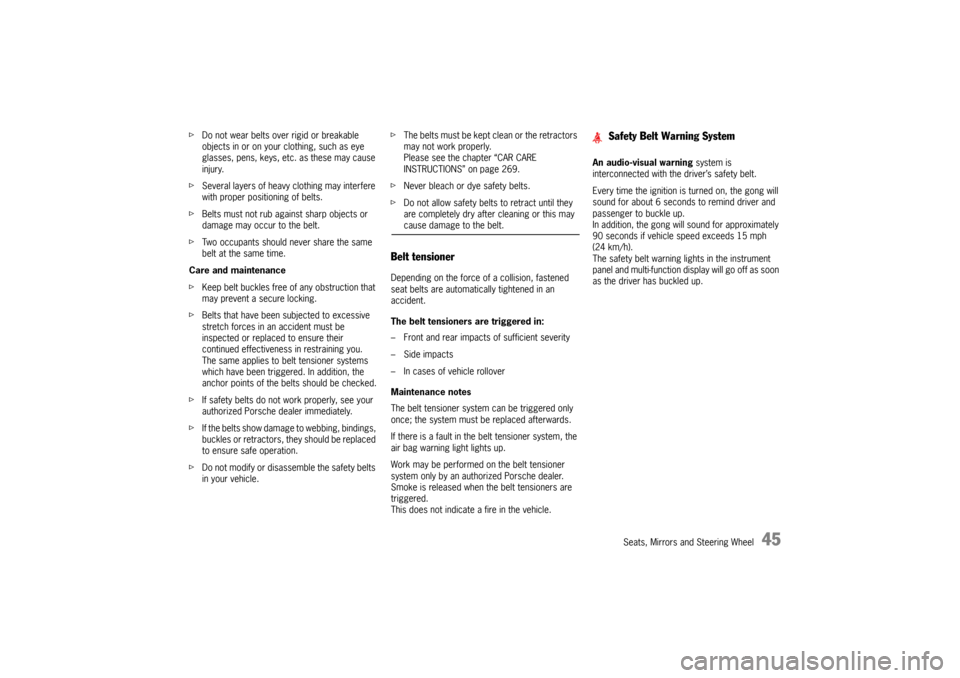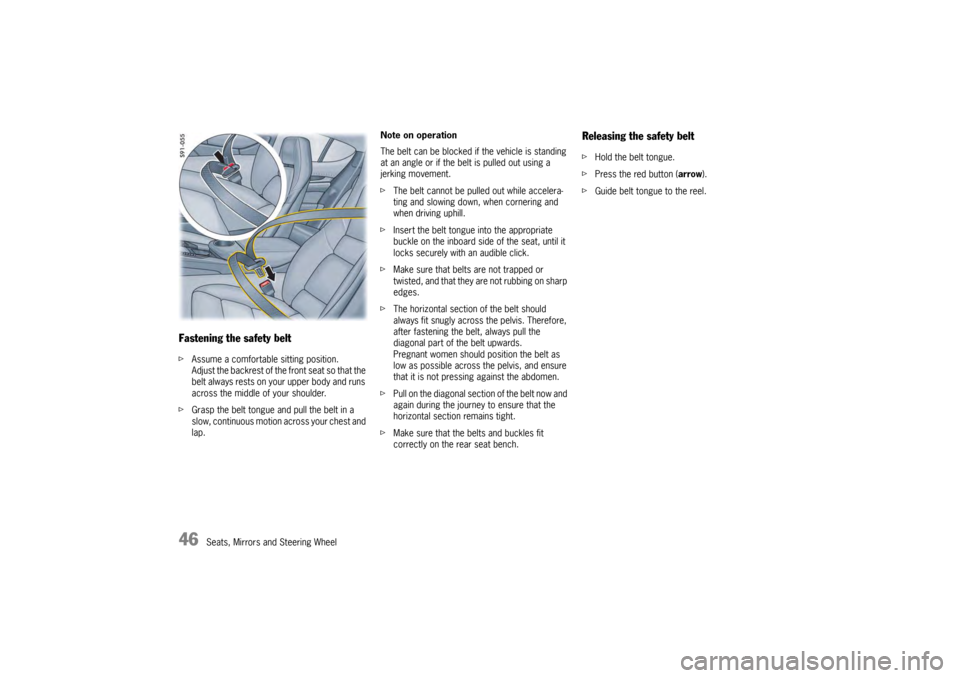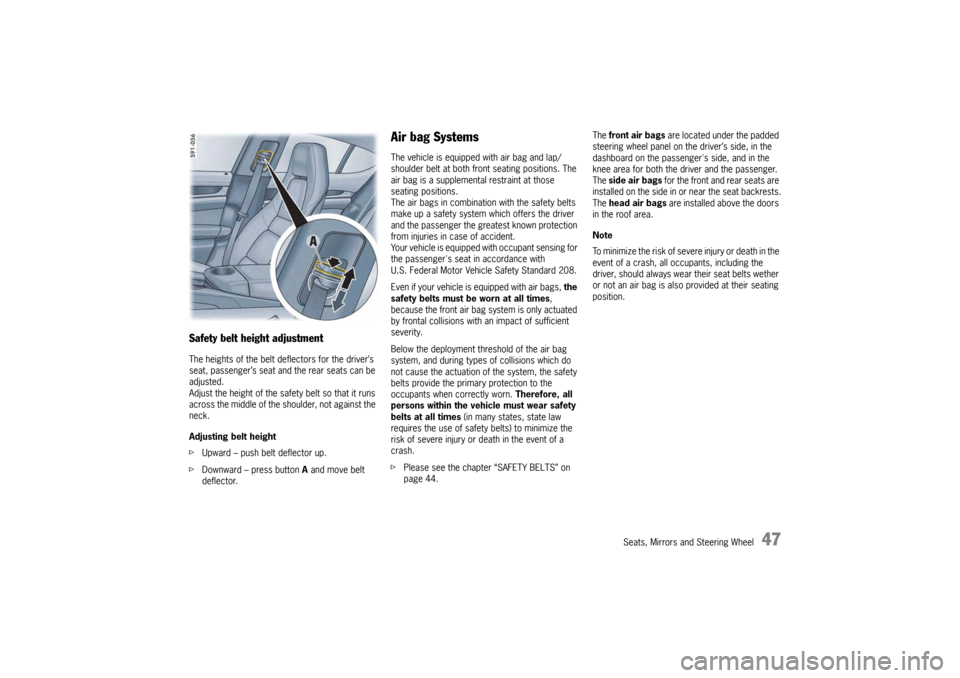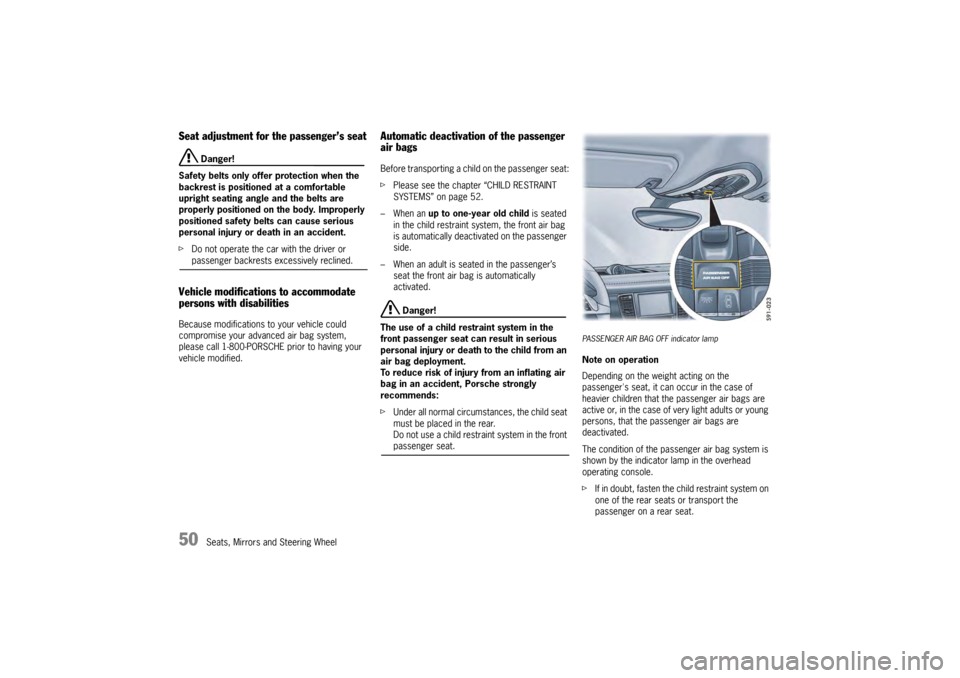2009 PORSCHE PANAMERA steering
[x] Cancel search: steeringPage 47 of 343

Seats, Mirrors and Steering Wheel
45
fDo not wear belts over rigid or breakable
objects in or on your clothing, such as eye
glasses, pens, keys, etc. as these may cause
injury.
f Several layers of heavy clothing may interfere
with proper positioning of belts.
f Belts must not rub against sharp objects or
damage may occur to the belt.
f Two occupants should never share the same
belt at the same time.
Care and maintenance
f Keep belt buckles free of any obstruction that
may prevent a secure locking.
f Belts that have been subjected to excessive
stretch forces in an accident must be
inspected or replaced to ensure their
continued effectiveness in restraining you.
The same applies to belt tensioner systems
which have been triggered. In addition, the
anchor points of the belts should be checked.
f If safety belts do not work properly, see your
authorized Porsche dealer immediately.
f If the belts show damage to webbing, bindings,
buckles or retractors, they should be replaced
to ensure safe operation.
f Do not modify or disassemble the safety belts
in your vehicle. f
The belts must be kept clean or the retractors
may not work properly.
Please see the chapter “CAR CARE
INSTRUCTIONS” on page 269.
f Never bleach or dye safety belts.
f Do not allow safety belts to retract until they
are completely dry after cleaning or this may
cause damage to the belt.
Belt tensionerDepending on the force of a collision, fastened
seat belts are automatically tightened in an
accident.
The belt tensioners are triggered in:
– Front and rear impacts of sufficient severity
– Side impacts
– In cases of vehicle rollover
Maintenance notes
The belt tensioner system can be triggered only
once; the system must be replaced afterwards.
If there is a fault in the belt tensioner system, the
air bag warning light lights up.
Work may be performed on the belt tensioner
system only by an authorized Porsche dealer.
Smoke is released when the belt tensioners are
triggered.
This does not indicate a fire in the vehicle. An audio-visual warning
system is
interconnected with the driver’s safety belt.
Every time the ignition is turned on, the gong will
sound for about 6 seconds to remind driver and
passenger to buckle up.
In addition, the gong will sound for approximately
90 seconds if vehicle speed exceeds 15 mph
(24 km/h).
The safety belt warning lights in the instrument
panel and multi-function display will go off as soon
as the driver has buckled up.
Safety Belt Warning System
Page 48 of 343

46
Seats, Mirrors and Steering Wheel
Fastening the safety beltfAssume a comfortable sitting position.
Adjust the backrest of th e front seat so that the
belt always rests on your upper body and runs
across the middle of your shoulder.
f Grasp the belt tongue and pull the belt in a
slow, continuous motion across your chest and
lap. Note on operation
The belt can be blocked if the vehicle is standing
at an angle or if the belt is pulled out using a
jerking movement.
f
The belt cannot be pull ed out while accelera-
ting and slowing down, when cornering and
when driving uphill.
f Insert the belt tongue into the appropriate
buckle on the inboard side of the seat, until it
locks securely with an audible click.
f Make sure that belts are not trapped or
twisted, and that they ar e not rubbing on sharp
edges.
f The horizontal section of the belt should
always fit snugly across the pelvis. Therefore,
after fastening the belt, always pull the
diagonal part of the belt upwards.
Pregnant women should position the belt as
low as possible across the pelvis, and ensure
that it is not pressing against the abdomen.
f Pull on the diagonal sect ion of the belt now and
again during the journey to ensure that the
horizontal section remains tight.
f Make sure that the belts and buckles fit
correctly on the rear seat bench.
Releasing the safety beltfHold the belt tongue.
f Press the red button ( arrow).
f Guide belt tongue to the reel.
Page 49 of 343

Seats, Mirrors and Steering Wheel
47
Safety belt height adjustmentThe heights of the belt deflectors for the driver’s
seat, passenger’s seat and the rear seats can be
adjusted.
Adjust the height of the safe ty belt so that it runs
across the middle of the shoulder, not against the
neck.
Adjusting belt height
f Upward – push belt deflector up.
f Downward – press button A and move belt
deflector.
Air bag SystemsThe vehicle is equipped with air bag and lap/
shoulder belt at both front seating positions. The
air bag is a supplemental restraint at those
seating positions.
The air bags in combinatio n with the safety belts
make up a safety system which offers the driver
and the passenger the greatest known protection
from injuries in case of accident.
Your vehicle is equipped with occupant sensing for
the passenger's seat in accordance with
U.S. Federal Motor Vehicle Safety Standard 208.
Even if your vehicle is equipped with air bags, the
safety belts must be worn at all times ,
because the front air bag system is only actuated
by frontal collisions with an impact of sufficient
severity.
Below the deployment threshold of the air bag
system, and during types of collisions which do
not cause the actuation of the system, the safety
belts provide the primary protection to the
occupants when correctly worn. Therefore, all
persons within the vehicle must wear safety
belts at all times (in many states, state law
requires the use of safety belts) to minimize the
risk of severe injury or death in the event of a
crash.
f Please see the chapter “SAFETY BELTS” on
page 44. The
front air bags are located under the padded
steering wheel panel on the driver’s side, in the
dashboard on the passenger's side, and in the
knee area for both the driver and the passenger.
The side air bags for the front and rear seats are
installed on the side in or near the seat backrests.
The head air bags are installed above the doors
in the roof area.
Note
To minimize the risk of seve re injury or death in the
event of a crash, all occupants, including the
driver, should always wear their seat belts wether
or not an air bag is also provided at their seating
position.
Page 50 of 343

48
Seats, Mirrors and Steering Wheel Danger!
To provide optimal occupant protection, air
bags must inflate at very high speed. If you
are not wearing your safety belt or are too
close to the air bag when it is deployed,
inflating air bags can result in serious
personal injury or death.
f Make sure there are no people, animals or
objects between the driver or passenger and
the area into which the air bags inflate.
f Sit back as far from the dashboard or steering
wheel as is practical, while still maintaining full
vehicle control.
f Always hold the steering wheel by the outer
rim. Never rest your hands on the air bag
panel.
f Always fasten seat belts because triggering
of the air bag system depends on the force
and angle of impact.
f Do not transport heavy objects on or in front of
the passenger seat. These could impair the
function of the air bags, the seat belts, and
occupant sensing.
f Do not hang objects (e. g., jackets, coats,
coat hangers) over the backrest. f
Always keep the lid of the door storage
compartment closed. Objects must not
protrude out of the door storage
compartment.
f Do not add any additional coverings or stickers
to the steering wheel or in the area of the
passenger air bag, side air bags, knee air
bags, and head air bags. Doing so may
adversely affect the functioning of the air bag
system or cause harm to the occupants if the
air bag system should deploy.
f No objects should be placed over or near the
air bag on the instrument panel, because any
such objects could cause harm if the vehicle is
in a crash severe enough to cause the air bag
to inflate.
f Do not modify the seat coverings, since such
changes can block the seat-mounted side air
bag. Do not attach additional cushions,
protective coverings, or pillows to the
passenger's seat. Do not affix things to the
passenger's seat or cover it with other
materials. Do not cover the back of the
backrest. Do not make changes to the
passenger's seat, the cushion or foam, the
occupant sensor, and to the seat base frame.
f No changes must be made to the wiring or
components of the air bag system.
f Do not install any wiring for electrical
accessory equipment in the vicinity of the air
bag wiring harnesses. Doing so may disable the air bag system or cause inadvertent
inflation.
f If the warning light comes on, the air bag
system should be repaired immediately by
your authorized Porsche dealer.
f Always keep feet in the footwell while driving.
Do not put feet on the dashboard or the seat
area. Do not lean against the inside of the door
or outside the window while the vehicle is
moving.
f Using accessories not approved by Porsche
can cause the occupant sensing to be
impaired.
f Do not squeeze objects, such as the fire
extinguisher, or first aid kit under the seat.
f Only have seats removed and installed by an
authorized Porsche dealer so that occupant
sensing components will not be damaged.
f Give your passenger all of the information in
this chapter.
Note
Air bag components (e.g. steering wheel, seats)
may be disassembled only by an authorized
Porsche dealer.
f When disposing of a used air bag unit, our
safety instructions must be followed. These
instructions can be obtained at any authorized
Porsche dealer.
Page 51 of 343

Seats, Mirrors and Steering Wheel
49
Function of the air bag systemAir bags are a supplemental safety system. Your
primary protection comes from your safety belts.
The front air bags are triggered during a frontal
collision of sufficient force and direction.
In the event of a side impact of corresponding
force, the side air bag on the impact side is
triggered.
The inflation process generates the amount of gas
required to fill the air bags at the necessary
pressure in fractions of a second.
Air bags help to protect the head and body, while
simultaneously damping the motion of the driver
and passenger in the impact direction in the event
of a frontal impact or side impact.
In order to help provide protection in severe
collisions which can cause death and serious
injury, air bags must inflate extremely rapidly.
Such high speed inflation has a negative but
unavoidable side effect, which is that it can and
does cause injuries, including facial and arm
abrasions, bruising and broken bones. You can
help minimize such injuries by always wearing your
safety belts.
There are many types of accidents in which air
bags are not expected to deploy. These include
accidents where the air bags would provide no
benefit, such as a rear impact against your
vehicle. Other accidents where the air bags are
designed not to deploy are those where the risk of
injury from the air bag deployment could exceed any protective benefits, such as in low speed
accidents or higher speed accidents where the
vehicle decelerates over a longer time. Since air
bag deployment does not occur in all accidents,
this further emphasizes the need for you and your
passengers to always wear safety belts.
Your vehicle is equipped with a crash sensing and
diagnostic module. This module will record the
use of the seat belt restraint system by the driver
and front passenger when the air bags and/or belt
tentioner are triggered.
Precondition for activating the restraint systems:
f
Ignition is switched on.
Advanced air bagYour vehicle is equipped with occupant sensing for
the passenger's seat in accordance with
U.S. Federal Motor Vehicle Safety Standard 208.
Depending on the weight, body positioning and
shape acting on the passenger's seat, the
passenger's air bag will automatically be switched
on and off.
Depending on the angle and force of impact, the
passenger's air bag which is switched-on will be
triggered during a collision.
Precondition for switching the passenger's air bag
on and off, depending on weight, body positioning
and shape:
fIgnition is switched on.
Danger!
Risk of serious personal injury or death due
to the passenger air bag not triggering.
Improper handling of occupant sensing can
unintentionally impair switching the
passenger's air bag off and on.
If the weight on the passenger's seat is
reduced significantly, e.g., by supporting
weight on the armrest, the passenger's air
bag can be switched off.
f Select an upright seat position, and do not
support weight on the armrests or lean out of
the window.
Always keep feet in the footwell while driving.
Do not put feet on the dashboard or the seat
area. Do not lean against the inside of the door
or outside the window while the vehicle is
moving.
f If a child restraint system is installed on the passenger’s seat, do not adjust the seat.
Page 52 of 343

50
Seats, Mirrors and Steering Wheel
Seat adjustment for the passenger’s seat
Danger!
Safety belts only offer protection when the
backrest is positioned at a comfortable
upright seating angle and the belts are
properly positioned on the body. Improperly
positioned safety belts can cause serious
personal injury or death in an accident.
f Do not operate the car with the driver or passenger backrests excessively reclined.
Vehicle modifications to accommodate
persons with disabilitiesBecause modifications to your vehicle could
compromise your advanced air bag system,
please call 1-800-PORSCHE prior to having your
vehicle modified.
Automatic deactivation of the passenger
air bagsBefore transporting a child on the passenger seat:
fPlease see the chapter “CHILD RESTRAINT
SYSTEMS” on page 52.
– When an up to one-year old child is seated
in the child restraint system, the front air bag
is automatically deactivated on the passenger
side.
– When an adult is seated in the passenger’s seat the front air bag is automatically
activated.
Danger!
The use of a child restraint system in the
front passenger seat can result in serious
personal injury or death to the child from an
air bag deployment.
To reduce risk of injury from an inflating air
bag in an accident, Porsche strongly
recommends:
f Under all normal circumstances, the child seat
must be placed in the rear.
Do not use a child restra int system in the front passenger seat.
PASSENGER AIR BAG OFF indicator lampNote on operation
Depending on the weight acting on the
passenger's seat, it can occur in the case of
heavier children that the passenger air bags are
active or, in the case of very light adults or young
persons, that the passenger air bags are
deactivated.
The condition of the passenger air bag system is
shown by the indicator lamp in the overhead
operating console.
f If in doubt, fasten the child restraint system on
one of the rear seats or transport the
passenger on a rear seat.
Page 53 of 343

Seats, Mirrors and Steering Wheel
51
Note
fAfter switching on the ignition, the
PASSENGER AIR BAG OFF warning light lights
up for a few seconds as a check.
PASSENGER AIR BAG OFF indicator lamp
lights up
The passenger’s air bags are switched off.
PASSENGER AIR BAG OFF indicator lamp
does not light up
The passenger’s air bags are active and ready for
operation.
Danger!
Risk of serious personal injury or death due
to the passenger air bag triggering
unintentionally.
When the ignition is on and the up to one-
year old child is seated in the child restraint
system on the passenger seat the indicator
lamp “PASSENGER AIR BAG OFF“ must be
on.
If the “PASSENGER AIR BAG OFF” indicator
lamp does not light up, it could indicate a
fault in the system, and the air bag could
inflate in a collision, placing the child at risk
of death or severe injury from the inflating air
bag.
In this case:
f Fasten the child restraint system on one of the
rear seats immediately.
f Have the fault remedied at your nearest authorized Porsche dealer. Faults are indicated by a warning light in the
instrument panel.
The air bag warning light illuminates when the
electronic monitoring of the air bag system
detects a malfunction of the
sensors, safety belt
system, occupant detection system, PASSENGER
AIR BAG OFF indicator lamp, related wiring, air bag
modules and control units.
f In the following cases you should
immediately consult an authorized
Porsche dealer in order to assure the air
bag system is functioning properly:
– If the warning light does not light up when the ignition is switched on or
– If the warning light does not go out once the engine is running or
– If the warning light appears while driving.
Warning light
Page 54 of 343

52
Seats, Mirrors and Steering Wheel
Important informationIf you sell your Porsche, notify the purchaser that
the vehicle is equipped with air bags, and refer
them to the chapter „Air bag systems“ in the
owner’s manual (safety and disposal rules).
Further information on the air bag system can be
found on stickers attached to the sun visors, as
well as on all air bag components.
For special recommendations on the use of child
restraints:
f Please see the chapter “CHILD RESTRAINT
SYSTEMS” on page 52.
Child Restraint SystemsPorsche recommends that all infants and children
be restrained in child restraint systems at all times
while the vehicle is in motion in accordance with
applicable laws.
When possible, use only child restraint systems
recommended by Porsche. These systems have
been tested and adjusted to the interior of your
Porsche and the appropriate child age groups.
These child restraint systems are also designed to
be secured in vehicle seats by the lap belt portion
of the lap-shoulder-belt.
Other systems have not been tested and could
entail an increased risk of injury. The use of infant or child restraints is required by
law in all 50 US states and the Canadian
provinces. The child restraint system should be
one that complies with
U.S. Federal/Canadian
Motor Vehicle Safety Standards and should be
secured by a lap belt portio n of a lap-shoulder belt
or for child seats equipped with the LATCH sytem
( L ower A nchorage and Tether for Children, also
known as ISOFIX) to the LATCH anchorages.
You can obtain child seats that are LATCH
compatible at your authorized Porsche dealer.
f Always observe the separate installation
instructions for your child seat.
A statement by the seat manufacturer of
compliance with this federal standard can be
found on the instruction label on the restraint and
in the instruction manua l provided with the
restraint.